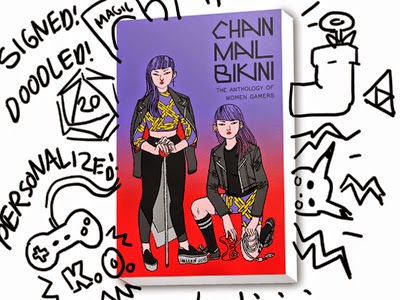I've been thinking a lot about women in sports lately, from a couple of different angles. I'm not much of a sports enthusiast, but I enjoy watching baseball and cycling and sometimes other games that pit talented players against each other for an engaging match up. I get frustrated that so often it's only men being shown on my television, and I give up trying to find something to watch and instead go back to my shows or my reading.
But in March, I start to get a bit excited because I know that there will be lots of women's basketball to watch. Even though I'm not really much of a basketball fan, I can appreciate the skill involved, and I find it pretty easy to get caught up in the excitement.
And I catch myself thinking,
What a long way we've come in the last 43 years since the passage of Title IX! But have we really come a long way? If you'd asked anyone in 1972 what they thought women's sports would look like in 2015, I'd wager many of them would have expected to see women's teams for most major sports being broadcast alongside the men's. I know that's what I had expected to happen while I was growing up. So, now I look around and while I can celebrate how far we've come, I also have to acknowledge my disappointment that we aren't further along.
Like many kids of my generation and younger, I grew up playing soccer, and two of my closest girl cousins both played softball. I have friends and family members who played sports in college (volleyball, basketball and soccer), and I know women who continue to compete in sports leagues as adults (hockey, soccer, and cycling).
This seems natural and normal and it's easy to think that it has always been thus. But it wasn't. Advances in women's sports have had a long, uphill, arduous path to overcome deeply ingrained societal norms. In the 70s, I remember reading about the life of Louisa May Alcott, and one of the stories about her that had a large impact on me as a child, and has stuck with me all these years later, was that she was an advocate for women's athletics, and that at the time it was quite unusual.
So when I started my research on Senda Berenson Abbott, the "Mother of Women's Basketball," and her efforts to bring team sports and athletics to girls and women in the 1890s and 1900s, I immediately remembered Louisa's story, and it helped me to put it into perspective.

Senda was born in 1868, in Vilna, Lithuania. Her parents moved to the United States when she was seven. She was a frail child, often sick, and she spent much of her childhood at home. She did not encounter many opportunities for physical activity until she was already an adult. Those she did, she probably lacked the requisite muscle tone and ability to pursue. It wasn't until she was forced to leave off her studies at the Boston Conservatory for Music for the second time due to her health that she sought help.
It was around this time that a new style of athletics was taking root in the Boston area. Prior to the mid-1880s, many gymnastics programs were organized according to the German style, which emphasized competitiveness and overall strength building, used large equipment, and had a striking militaristic theme. In 1889,
Mary Hemenway, a local philanthropist and all-round amazing woman herself (note to self, research Mary Hemenway, ASAP), founded the Boston Normal School of Gymnastics and began offering classes for teachers in Swedish style gymnastics. The Swedish System, or the "Swedish Movement Cure," was a a lighter version of gymnastics, which focused more on the intrinsic health value of movement and fitness.
Depressed about her inability to sit long enough to take piano lessons and having to drop out of the conservatory, again, Senda, decided to try taking classes at the School of Gymnastics. At first, she was not admitted, since it was only open to people who'd graduated from high school and who were already in adequate physical condition. Senda had been forced to leave school because of health issues, which meant she was disqualified on two accounts. But she met with the director, Amy Homans, who was convinced to allow her to take classes, with the belief that the class would help to improve her physical condition.

It was difficult, to say the least. Senda hated it. Five minutes of light exercise left her sore and worn out. She wanted to quit. But she stuck with it, and within three months, she started to see improvements. By the end of the year, she could complete the recommended two hours of exercise every day, and her health had improved dramatically. She enrolled for a second year, where she learned anatomy, physiology, and hygiene, with the intention of becoming a gymnastics teacher. Her improvement was so striking, and her conversion to the benefits of regular exercise so remarkable, she was sent to Andover, Massachusetts, to teach the Swedish system at the elementary school twice a week. This was a quite fortuitous event. While there, she learned of an opening at Smith College for a temporary gymnastic instructor, with the assumption that it would just last one year.
It was here that she truly made her lasting impact on the world of women's sports. She was on a mission to bring the benefits of exercise to the students of Smith. Fortunately for her, Smith College had just completed its state of the art Alumnae Gymnasium in 1890, providing her and its students with the best equipment. Convincing the faculty and the students of the importance of exercise, though, was a bit tougher. She had to work against the beliefs that exercise was not feminine, and many students were not enthusiastic about gymnastics in general.
She looked for ways to engage more of her students in physical activity. While attending a physical education conference at Yale University, she met Dr. James Naismith, the inventor of "basket ball." She was intrigued. The idea of introducing women to teams sports was daunting. At the time, teams sports were considered too rough for women. Uncertain about the kind of reception to expect, but undaunted, she decided to give it a try with her students. Other team games had not been popular with her students, but after one game of basket ball, the players were eager to try it again.
On March 22, 1893, she officially conducted the first game of women’s basketball. And the rest, as it is often said, is history.
OK. Not really. The young women did not care much for the standard rules put forth by Dr. Naismith, so Senda worked with them to modify the rules, making the game more enjoyable and suitable for female players who were not accustomed to the roughness of team sports.

At the end of her first year at Smith, she was asked to return for a second year, and her position had been made permanent. After only one year, in what was supposed to have been a temporary gig, she had managed to introduce team sports to young women, and spark a nation-wide trend. By 1899, she'd codified her rules for women's basket ball, and in 1901, her rules were published by the Spalding Athletic Library's
Basket Ball for Women. She remained the editor for each subsequent edition until the 1916/17 issue. Her rules for women's basketball remained practically unchanged until the mid-1960s.

Emboldened by the success of basket ball, she began to introduce other sports to the students of Smith College. After a trip to Sweden in 1893, she began a folk dancing program. And in 1901, she worked with
Lady Constance Applebee (another amazing woman to research!) of England to establish a field hockey program. She also introduced fencing and another new team sport, volleyball, to her students.
She remained dedicated to the cause of getting more women and girls involved in athletics throughout her life. She left Smith College shortly after getting married in 1911, but continued to teach physical education at the
Mary A. Burham School in Northampton.
In 1985, she became the first woman inducted into the Basketball Hall of Fame. She was the inducted to the Jewish Sports Hall of Fame in 1987, and the Women's Basketball Hall of Fame in 1999.
Photo of UCONN women's basketball team from
ESPNW
Photos of Senda Berenson Abbott from
Smith College Archives.
For more information:
Wikipedia:
Senda Berenson Abbot
Jewish Women's Archives:
Senda Berenson
You may also be interested in:
Today in Herstory - Althea Gibson
Althea Gibson came to tennis later than most who pursued a professional career. But she was a natural, and quickly rose in the ranks of her local tennis circle. In fact, she was so good and so well loved by her community that in 1940 they took up a collection to pay for a junior membership and lessons at the prestigious Cosmopolitan Tennis Club.
Another Double Hitter: Movie Review & Shout-out
I would have loved to have known about Doris Sams and the other professional womens baseball players when I was a girl! No telling how I would have used that info. I wasn't especially athletically inclined, but it certainly would have been inspirational anyway. I'm sure I would have devoured biographies about women ball players if I had found any, the same way I read through every book I could find on Amelia Earhart.
Role Models - Billie Jean King
In college, she had to work two jobs to pay her way, even though male tennis stars were on full scholarship. If you ever needed a reminder of why Title IX is so important, just think of that. She said it was that realization that lead her to push for more equality in sports and in politics.





























































